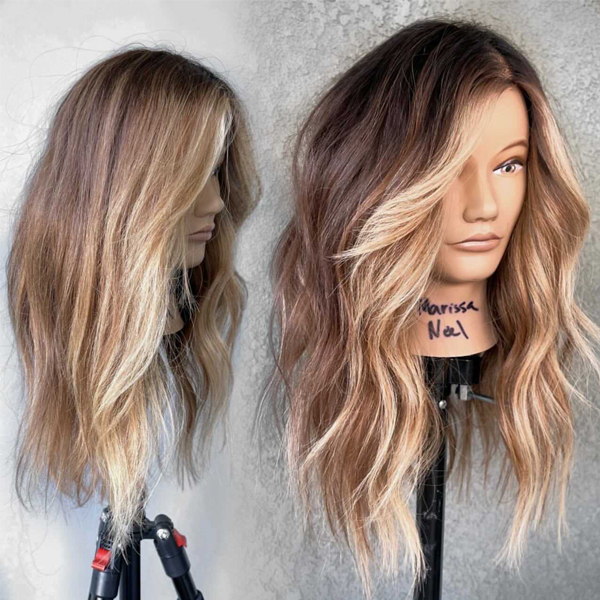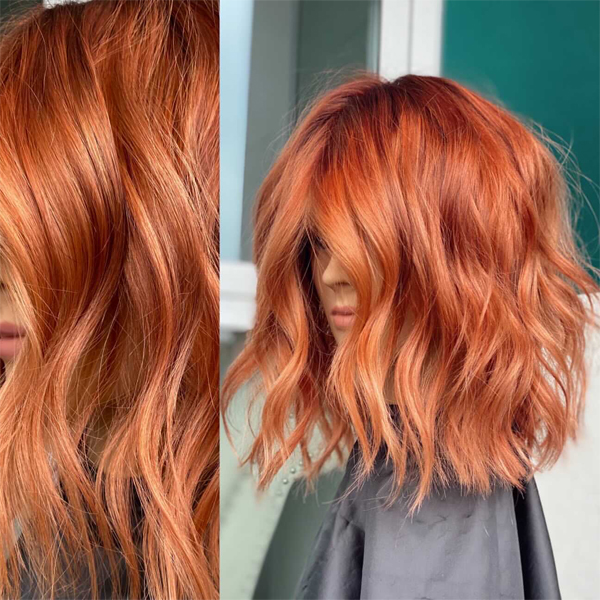4 Tips For Hand Painted Lowlights
How-To: Freehand Lowlights + Depth
‘Tis the season to add depth to blondes who are looking to go a bit deeper for the winter months—and we’re here to show you how it’s done! Hand painting lowlights are the easiest way to transform those routine bleach-and-tones and over-highlighted clients who could use a break from foils. Another reason we love it? It’s super speedy!
That’s why Alfaparf Milano US National Director Cassie Siskovic (@cassiskovic) and Marissa Mae Neel (@maeipaint) are sharing their application techniques for adding depth—watch the full tutorial above and keep scrolling for some key takeaway tips!
Use code APMxBTC for 15% OFF your first Alfaparf Milano order—click here!
1. Hairline Base Formulation Trick
The first step of hand-painted lowlights is the base application, suggests Cassie—especially if you’re dropping the client’s color down 1 to 2 levels deeper. This creates the foundation and allows the base color to oxidize before you start melting and painting depth into the mids and ends.
Prevent The Hairline From Going Too Dark:
The #1 potential problem area is the hairline, where the hair typically grabs more color. That’s why Marissa applies a darker base color to the crown and back, but when she gets to the face frame, she sections out a chunky money piece and switches to a base color that’s a level lighter.
Here’s Why: This creates a softer grow-out and maintains natural brightness. This also works great for root retouches. 😉
Pro Tip: Comb the base color through to create seamless diffusion between the fully saturated base and the mids.
2. How To Formulate For Adding Depth
No Filler Necessary: Cassie and Marissa’s go-to color for this technique is Alfaparf Milano Color Wear. It can fill up to three levels without needing to add any extra warmth or fillers. This is important for working with blonde clients who have over-highlighted, highly porous or bleached-out hair.
When To Use Clear: Marissa melts the base color into Clear around the money piece and connects the hairline at the nape, aka the hair that pushes forward into the face frame. Using Clear also creates a barrier between freehand-painted sections.
Pro Tip: Remember where your client’s natural shadows fall. Using diagonal-back sections around the face will push lightness forward and place depth behind it.
Check out Marissa’s transformation & tap the beaker for the color formulas!


3. Surface Saturating Technique
Cassie’s go-to melting method for adding depth is a variation of surface painting and fully saturating sections. This creates a variety of light and depth and leaves natural blonde underneath, which makes this ideal for a blonde who is transitioning to dark for the first time.
Section Size: The finer the hair, the larger the sections should be for surface painting. If the sections are too small, it’s easy to get splotchiness or bleeding.
Natural Fall: Keep the elevation as natural as possible, use high tension and load the product on one side of the brush before gliding on the surface.
Avoid Splotchy Color: The end goal is to melt everything together, so don’t use anything to separate sections. When you lay the hair down, do so delicately to avoid spots.
Try This Trick At The Shampoo Bowl: After surface saturating and processing, emulsify all of the hair together at the bowl and process for an additional five minutes.
Tap the beaker for Cassie’s color formulas!


Slide for the dramatic before & after!

4. Don’t Be Afraid Of The Dark
Depending on porosity—especially for bleach-and-tone regulars—the color will see a little fade out. Don’t be afraid to formulate deeper for more longevity. Just make sure to have a conversation with blonde clients about realistic expectations and how their color care will change.
Products Used
More from
Alfaparf Milano
-
Blonde
The Biggest Hair Color Trends of 2024
-
Blonde
Coverage In Dimensional Color: 3 Mistakes To Avoid
-
Balayage
Cowboy Copper Reverse Balayage Dos & Don’ts
-
BTC Events
BTC “On Tour” Nashville Recap: Everything You Missed
-
Celebrity
“Hairstyle: The Talent Show” Is Now Airing—Here’s What To Know
-
Events
4 Reasons You Need To Attend Alfaparf’s #LOVEYOUREVOLUTION Tour
-
Uncategorized
How To Formulate A Classic Golden Blonde Toner
-
Blonde
Warm Honey Blonde Curls
-
Blonde
4 Placement Tips To Create Depth When Blonding
-
Balayage
The Money Piece: How To Adjust For Natural Or Bold Balayage
-
Best Of 2022
10 Toning Tips You’ll Need in 2023
-
Balayage
5 Tips To Upgrade Your Cutting, Blonding & Styling Techniques
-
Industry Events
HairStyle: The Talent Show—Enter To Win This TV Contest!
-
BTC Quickies
5 Quickie Hair Cheats We Stole From Instagram
-
Awards Shows
Alfaparf Milano Announces Colorist of The Year 2022 Winner
-
Balayage
How To “Fake” A Full Foil—Try This Genius Trick!
-
The BTC Show
#THEBTCSHOW 2022
-
Facebook Lives
3 Hacks For Coloring Rich Copper Curls
-
Curls
4 Tips For Defined Curls To Try Right Now
-
Foilayage
4 Foilayage Placements for Brighter Blends
-
Brunette
Semi di Lino Brunette Anti-Orange Conditioner
-
Brunette
Semi di Lino Brunette Anti-Orange Low Shampoo
-
Glossing/ Toning
Color Wear Gloss Toner
-
Balayage
3 Tips To Create A Watercolor Balayage






